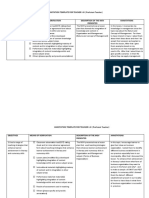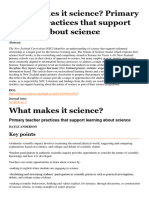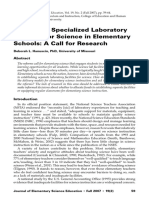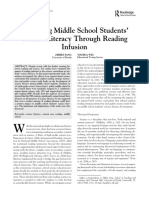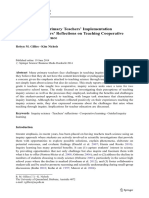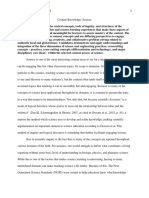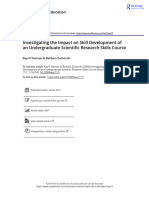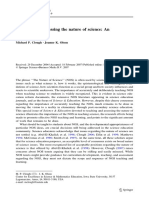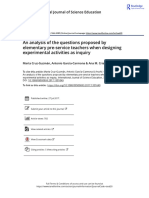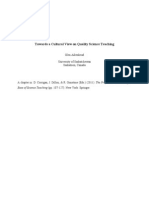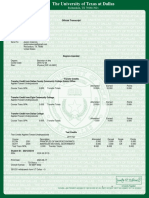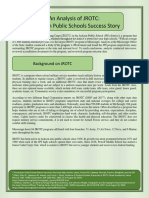School Site To Museum Floor: How Informal Science Institutions Work With Schools
School Site To Museum Floor: How Informal Science Institutions Work With Schools
Uploaded by
Aditi Sameer0 ratings0% found this document useful (0 votes)
8 views21 pagesTwo research studies investigated the programmes informal science institutions (ISIs) currently provide to support K-12 science education. ISIs reported a tendency for their programmes to be under-subscribed, and said funding was the biggest barrier to their ability to provide these programmes. Researchers administered an intensive survey to over 310 ISIs with teacher PD offerings to obtain detail regarding the programming.
Original Description:
Original Title
26655459
Copyright
© © All Rights Reserved
Available Formats
PDF, TXT or read online from Scribd
Share this document
Did you find this document useful?
Is this content inappropriate?
Report this DocumentTwo research studies investigated the programmes informal science institutions (ISIs) currently provide to support K-12 science education. ISIs reported a tendency for their programmes to be under-subscribed, and said funding was the biggest barrier to their ability to provide these programmes. Researchers administered an intensive survey to over 310 ISIs with teacher PD offerings to obtain detail regarding the programming.
Copyright:
© All Rights Reserved
Available Formats
Download as PDF, TXT or read online from Scribd
Download as pdf or txt
0 ratings0% found this document useful (0 votes)
8 views21 pagesSchool Site To Museum Floor: How Informal Science Institutions Work With Schools
School Site To Museum Floor: How Informal Science Institutions Work With Schools
Uploaded by
Aditi SameerTwo research studies investigated the programmes informal science institutions (ISIs) currently provide to support K-12 science education. ISIs reported a tendency for their programmes to be under-subscribed, and said funding was the biggest barrier to their ability to provide these programmes. Researchers administered an intensive survey to over 310 ISIs with teacher PD offerings to obtain detail regarding the programming.
Copyright:
© All Rights Reserved
Available Formats
Download as PDF, TXT or read online from Scribd
Download as pdf or txt
You are on page 1of 21
International Journal of Science Education
Vol. 29, No. 12, 8 October 2007, pp. 14891507
ISSN 0950-0693 (print)/ISSN 1464-5289 (online)/07/12148919
2007 Taylor & Francis
DOI: 10.1080/09500690701494084
RESEARCH REPORT
School Site to Museum Floor: How
informal science institutions work
with schools
Michelle Phillips
a
*, Doreen Finkelstein
b
and
Saundra Wever-Frerichs
c
a
Inverness Research Associates, USA;
b
The College Board, USA;
c
Kings College
London, UK
Taylor and Francis Ltd TSED_A_249282.sgm 10.1080/09500690701494084 International Journal of Science Education 0950-0693 (print)/1464-5289 (online) Original Article 2007 Taylor & Francis 29 12 000000October 2007 MichellePhillips mphillips07@gmail.com
Two research studies sponsored by the Centre for Informal Learning and Schools (CILS) investi-
gated the programmes informal science institutions (ISIs) currently provide to support K12
science education, particularly in the area of teacher professional development (PD). The first
study was a large-scale survey with 475 ISIs responding about the programmes they offer schools
and teachers beyond one-day field trips. A large majority of ISIs (73%) reported having one or
more of these programmes, with more than one-half (59%) providing one or more forms of teacher
PD. ISIs also reported a tendency for their programmes to be under-subscribed, and said funding
was the biggest barrier to their ability to provide these programmes. A second study focused on
ISI-based teacher PD programmes, looking at whom they serve, how they are funded, and their
specific programmatic elements. This study also investigated the extent to which ISI-based PD
incorporates features shown to produce measurable effects on teachers instructional practice.
Researchers administered an intensive survey to over 310 ISIs with teacher PD offerings to obtain
detail regarding the programming. The findings reported here indicate that the particular promise
of ISI-based teacher PD is the potential to incorporate features of PD that have been shown by
research to produce measurable effects on teachers practice. The results from these two studies
suggest that while some opportunities may be missed to leverage the strengths of the ISIs learning
environment in K12 science education, ISIs continue to support K12 science education in the
United States in important and varied ways.
Introduction
Learning in out-of-school settings, often referred to as informal learning, has long
been studied for how its attributes and processes differ from learning in schools,
often referred to as formal learning (Falk, 2001; Scribner & Cole, 1973). Literature
*Corresponding author. 1 Nebraska Street, San Francisco, CA 94110, USA. Email:
mphillips07@gmail.com
1490 M. Phillips et al.
that addresses learning in museums and informal science institutions (ISIs), such as
zoos, aquaria, and nature centres, often describes the opportunities that out-of-
school environments offer learners, such as free choice to explore what is meaningful
and intrinsically interesting to them, a collaborative and social learning experience,
and authentic experiences using real objects, phenomena, or animals (Bitgood,
Serrell, & Thompson, 1994; Falk & Dierking, 1992; Hein, 1998).
Museums and ISIs are out-of-school learning environments with a history of
partnering with schools through field trips and outreach programmes, and, more
recently, teacher professional development (PD) programmes, thereby blending
elements of the ISIs less-structured setting with the more structured requirements
and goals of the K12 educational system (Hein, 2001; Hofstein & Rosenfeld, 1996;
Inverness Research Associates, 1996; Ramey-Gassert, Walberg & Walberg, 1994).
An intensive manifestation of this blend is the museum-school, where students
regularly study in both classroom and museum environments (King, 1998), and
where the distinctions between particular learning settings are blurred (Klein, Corse,
Grigsby, Hardin, & Ward, 2001) almost to the point of being erased.
Science education reform efforts in the USA have increasingly recognized the
importance of incorporating inquiry-based and investigation-based learning into
school science curricula (NRC, 2000) and have promoted greater use of learner-
centred pedagogy and collaborative learning in schools (AAAS, 1989, NRC, 1999).
These are already central features of the ISI learning environment (Falk & Dierking,
1992; Rennie, Feher, Dierking & Falk, 2003); therefore, ISIs have the potential to
play a key role in K12 science education reform efforts. Now, more than ever, it is
important to understand the realities and nature of ISIs work with K12 schools.
The two research studies reported in this paper are surveys of a broad range of
ISIs regarding the programmes they offer in support of K12 science education, and,
as a result, investigate and document the ways that the learning contexts, resources,
and approaches of ISIs are contributing to school-based K12 learning across the
USA. Study 1 is primarily an empirical study that documents the current extent of
ISIs involvement with schools, and the range and diversity of the educational
programmes they offer. Study 2 focuses specifically on K12 teacher PD
programmes offered by ISIs. While Study 2 is, in part, an empirical study designed
to document the nature and range of ISI-based teacher PD programmes, it is also
grounded in the theory, research findings, and literature describing the characteris-
tics and nature of PD programmes that have been shown to produce a measurable
change in teachers practice. Study 1 and Study 2 are complementary, and coupling
the findings of both provides a relatively rich portrait of the numerous and varied
ways in which ISIs work with schools.
Study 1
If ISIs can serve important roles in school-based science education through their
informal learning contexts, resources, and pedagogy, a critical question is: To what
extent are they doing so? Two previous studies have addressed this question. Ten
Informal Science Institutions Work with Schools 1491
years ago, Inverness Research Associates (1996) conducted a survey of the ISI field
and found that, at the time, ISIs provided a wide base of support for school science
education. The report of the survey findings, An Invisible Infrastructure: Institutions of
Informal Science Education, concluded that informal science institutions do indeed
provide infrastructure for science education, contributing in significant ways to the
teaching of science in the nations schools (Inverness Research Associates, 1996,
p. 18). More recently, the Institute of Museum and Library Services (IMLS, 2002)
conducted a survey of museums programmes for schools and also found a strong
connection between museums and K12 education. However, because the IMLS
survey did not differentiate between ISIs and other types of museums, including art
and history museums, the reported findings were less illuminating about ISIs or
science education specifically. Importantly, however, IMLS survey found that
science was one of the content areas least frequently targeted in museums
educational programming (IMLS, 2002).
The first study reported here sought to fill the gap in knowledge about how
informal science institutions are currently working with K12 schools and support-
ing K12 science education in the USA. The purpose of the study was to document
the range and diversity of programmes that are currently being offered by ISIs to
serve and support school-based science education, and to identify patterns in how
ISIs currently support K12 education in the USA.
Methodology
Development of the ISI database. There is no comprehensive source of all of the
names and addresses of every ISI within the USA, but there are professional organi-
zations that maintain lists of member institutions, and the American Association of
Museums gathers and publishes contact information for museums and other types of
informal learning institutions on an annual basis. These were the main sources
researchers used to develop a database of ISIs within the USA. Organization
member lists were obtained from the American Association of Botanical Gardens
and Arboreta, the American Zoo and Aquarium Association, the Association of
Childrens Museums, and the Association of ScienceTechnology Centres. Contact
information was taken from the 2004 edition of the Official Museum Directory (Amer-
ican Association of Museums, 2004) for nature centres, organizations self-identified
as science institutions (including natural history museums and planetaria), and
specialized electricity and technology museums. A final source of contact informa-
tion for ISIs was personal communication to the research team and networking
efforts among museum professionals.
The resulting database included a broad cross-section of many types of ISIs within
the USA, and researchers felt it was acceptably representative of the ISI field. Simi-
lar sources and methodologies have been used in other large-scale surveys of the ISI
and museum fields (American Association of Museums, 2003; Inverness Research
Associates, 1996). However, it is important to note that the majority of the
institutions in the database were affiliated in some way with a national professional
1492 M. Phillips et al.
association, and therefore it is probable that very small institutions tended to be
under-represented (American Association of Museums, 2003). The final database
consisted of 2,597 informal science institutions of varied types and sizes, represent-
ing all 50 States plus the District of Columbia.
The survey. A six-page survey was developed and mailed to all 2,597 institutions in
the ISI database. Institutions were given the choice of responding through the mail
or going to a secure web site where they could take the survey online. The majority
of respondents (72%) chose to respond through the mail. The ISI was considered to
offer support for K12 science education if the respondent answered yes to the
following question: Does your institution provide support in the way of
programmes, workshops, materials, curricula, etc., for districts, schools, teachers, or
students in the broad area of science education besides a one-day field trip? One-
day field trips were excluded from the definition of support in order to identify ISIs
with programmes specifically designed for K-12 education as opposed to museum
visitors in general. Field trips that included some form of structure and educational
support from the ISI, such as classroom activities that precede or follow up the field
trip, were included in the definition of support.
Survey questions gathered information on the institution (e.g., ISIs budget size,
staff size), the ISIs relationships with K12 schools and districts (e.g., characteris-
tics of the served schools and districts, school or district funding and support), and
the implementation of specific programmes (e.g., type, utilization, and evaluation).
The survey included a section of questions that ISIs were asked to answer in terms of
one specific, randomly assigned type of programme that they offer for K12 science
education. This random assignment was accomplished through the following steps:
(1) A table in the survey listed 13 types of programmes to serve K12 science educa-
tion that were of interest and might be offered by the ISIs. (2) Thirteen different
versions of the survey instrument were created, each with one of the 13 listed
programme types in the first position of the table and with the other 12 programme
types listed in a random orderdifferent random orders were used on each version.
(3) Each ISI was randomly assigned to the survey version they received (identical via
mail and online for those ISIs that chose to respond over the Internet). (4) Instruc-
tions in the survey asked ISIs to answer the section of questions in terms of the first
programme type in the table that they offered. Responses were double-checked and
ISIs that did not correctly follow the instructions (n = 17) were removed from the
analysis for this section of questions.
This random assignment procedure did not result in exactly equal chances for
every programme type to be assigned because 13 orders were presented rather than
every possible order permutation (which was unfeasible). However, the researchers
felt that the procedure resulted in an acceptable approximation of true random
assignment. The obtained distribution of programme types that ISIs responded
about was similar to the obtained distribution of programme types that ISIs said they
offered; for example, teacher special events were 12% of all programme types offered
Informal Science Institutions Work with Schools 1493
out of the list, and 13% of the ISIs answered the section of questions in terms of
teacher special events.
Response rate. After an initial mailing and two follow-up mailings, completed
surveys were received back from 514 institutions, for an overall response rate of
20%. Of these 514 institutions, 39 did not meet the criteria of an ISI, which left a
final data-set of 475 ISIs.
1
These 475 responding ISIs included aquaria, arboreta,
botanical gardens, childrens museums, natural history museums, nature centres,
planetaria, science centres, zoos, and miscellaneous other types of ISIs.
As a method for assessing the degree to which there were systematic differences
between responding and non-responding ISIs, ISIs that responded to the first mail-
ing were compared with those that responded to the second and third mailings on
six demographic and educational support variables. No differences were found
between the three mailings on the following five tested variables: offering support for
K12 science education (
2
[2] = 3.57, ns); size of operating budget (F[2, 299]
= 0.21, ns); annual number of visitors (F[2, 318] = 0.55, ns); number of schools
served (F[2, 283 = 0.77, ns); or number of programmes offered (F[2, 472] = 1.56,
ns). A statistically significant difference (
2
[2] = 6.39, p <.05) was found for the last
tested variable, offering teacher PD: 64% of the ISIs that responded to the first mail-
ing offered one or more forms of teacher PD, while this figure dropped to 59% for
the second mailing and to 52% for the third mailing. Thus the prevalence of offering
teacher PD is probably slightly higher in the obtained data-set than it is in the ISI
field as a whole. These analyses suggest that the findings from the study are probably
not strongly skewed by self-selection factors, and that where self-selection factors do
play a role, they probably make the data-set more inclusive of ISIs that offer K12
educational support.
Findings
Types of ISI support for K12 science education. Almost three-quarters of the ISIs in
the data-set (345 institutions, 73%) responded that they provide support in the way
of programmes, workshops, materials, curricula, etc. for districts, schools, teachers,
or students in the broad area of science education besides a one-day field trip. This
demonstrates a very broad base of support for school-based science education that
extended across all of the different types of informal science institutions in the data-
set.
The survey listed 13 different, specific types of programmes and partnerships that
serve and support K12 science education and asked ISIs to indicate whether they
offered each type. Twelve of the 13 programmes listed were described exactly as
they were on the 1996 survey of the ISI field conducted by Inverness Research
Associates. That study found that, 10 years ago, these 12 programme types were
meaningful to ISIs and accounted for the majority of ISIs programmes for schools
that were being offered at the time.
2
A 13th programme (PD provider training) was
1494 M. Phillips et al.
also included in the survey because this type of training is integral to the work of the
Centre for Informal Learning and Schools, which sponsored this study. Finally, ISIs
were asked to describe any other programmes they offer that did not fall into one of
the 13 types listed on the survey. Most ISIs (63%) did not list any additional
programmes. For those that did, examples of other programme types described
included after school programmes, distance learning, home schooling programmes,
family science nights, overnight programmes, camps, and customized programmes.
The average number of programmes offered by ISIs out of the 13 types of
programmes listed on the survey was 3.7. Aquaria, science centres, and zoos were
most likely to offer support, with an average of between six and seven of these
programmes at their institutions. The 13 programme types listed on the survey fell
into the following four general categories:
Programmes that provide services directly to students.
Programmes that provide forms of teacher PD.
Programmes that involve being part of a collaborative or a national programme.
Programmes that provide materials and curricula for the classroom.
Table 1 presents the number and percentage of ISIs that offered at least one
programme within each of these four categories, in addition to the number and
percentage of ISIs that offered each specific type of programme. Direct-to-student
programmes such as structured and educationally supported field trips (55%) and
outreach (52%) were offered most often (65% combined), while materials support
(33%) and curriculum development for the classroom (27%) were offered least often
(42% combined).
The median number of schools served by ISIs was 40 and the median number of
districts served was eight. ISIs overwhelmingly served elementary schools over
middle and high schools, with elementary schools averaging 73% of the total schools
served. ISIs also were most likely to serve schools that had underserved students in
the schools student population: an average of 44% of the schools served were
described by ISIs as having a large number of underserved students, proportional
to the region.
Funding was a major constraint for ISIs. Out of a list of five possible barriers to an
ISIs ability to provide support for K12 educational programmes, the highest ranks
were given to the two that dealt with funding at the ISI and school/district level.
Lower-ranked barriers were institutional space, school/district policies, and staff
training.
Utilization of programmes. A surprising finding concerned the relationship between
the capacity of ISI programmes and their utilization. Survey respondents were asked
about programme capacity in terms of a randomly assigned programme out of the 13
types of programmes listed on the survey. More than one-half (53%) of ISIs
reported that the randomly assigned programme could handle a greater number of
participants than it currently serves, while only 24% of ISIs reported having to turn
Informal Science Institutions Work with Schools 1495
Table 1. Types of programmes offered by ISIs
Type of programme
Number
of ISIs
Percentage
of ISIs
a
Direct-to-student programmes 307 65
Structured and educationally supported field trips (providing teachers
with activities that precede and/or follow up on their students visits
to the institution)
259 55
Outreach programmes (van programmes, travelling demonstrations,
support for school science fairs, etc.)
245 52
Teacher PD programmes 279 59
Teacher special events (one-day workshops or special gatherings that take
place on a single day)
205 44
Teacher multi-day workshops (PD events that last at least 8 h but less
than 40 h; e.g., a three-day workshop on a specific topic or a series of
five Saturday sessions)
117 25
Pre-service and formal teacher education connections (courses,
apprenticeships, pre-service observations, and/or research opportunities
for individuals enrolled in teacher education programmes)
107 23
Teacher coaching and classroom support (demonstrations, shared
teaching, and/or other forms of in-school support by staff or teacher
interns from your institution)
97 21
Teacher institutes (PD experiences, usually on consecutive days, that
cumulatively involve 40 h or more of participation)
76 16
PD provider training (training for administrators or staff providers of
teacher PD)
70 15
Teacher internships (teachers working in the museum on a full-time or
part-time basis, e.g., a teacher on a special assignment or a teacher
serving as a science specialist for the district)
61 13
Collaboratives and national programmes 217 46
Collaboratives or partnerships (the institution is a member of local
educational collaboratives, possibly involving schools, industry,
universities, or some combination)
212 45
National science education programmes (the institution serves as a base
for national-level programmes such as MESA
b
, the JASON
b
Project,
and Challenger Centres, which involve students and/or their teachers)
38 8
Classroom materials and curricula programmes 199 42
Materials and kit-based support (support in helping teachers, schools, or
districts select, buy, make, borrow, organize, manage, replenish, and
repair classroom science teaching materials)
153 33
Curriculum development/support (institutional support for the
development and/or design of curricula, or technical assistance with
selecting curricula)
128 27
Total ISIs with at least one programme 345 73
Note:
a
These percentages have a margin of error (95% condence interval) of 5%. Schools served
by ISIs and funding support.
b
MESA, mathematics, engineering science achievement; JASON, the
JASON project (Jason is not an acronym, but is writen in capitals by convention).
1496 M. Phillips et al.
participants away. In order to look at potential differences in utilization across the
different kinds of programmes, the 13 specific programme types were collapsed into
four categories and a chi-square analysis was run. As can be seen in Table 2, there
was no significant difference in this finding across the four categories of programmes
(
2
[3] = 3.59, ns); programmes in all categories were most frequently able to handle
more participants than they currently serve. This suggests that these programmes are
generally being under-utilized.
One possible alternative explanation for this finding is that ISIs are extremely
good at scaling their programmes up or down to meet demand, such that they
usually have the capacity to handle more participants. However, due to the perva-
siveness of the finding across programme categories and the earlier results regarding
ISIs difficulties with funding, this explanation seems unlikely to explain the trend
fully.
Methods of programme evaluation. Finally, ISIs were asked about the evaluation
methods they use, and were again asked to respond in terms of the randomly
assigned programme. ISIs could check off more than one method if multiple meth-
ods were used. ISIs reported that 93% of the programmes were evaluated by some
method, either formally or informally. The most common method was to gather
feedback about the programme and its effectiveness, either from the participants
(90% of programmes) or from school/district administrators (49% of programmes).
Methods of evaluation that are most useful for accountability requirements in
schoolsinvestigation of changes in teacher or student behaviour, teacher or
student attitude, and student achievementwere also used, but for less than 25% of
the programmes.
Discussion
The results from Study 1 show that the majority of ISIs play a role in K12 science
education and offer a wide range of programmes designed to support K12 teachers,
as well as students and schools. These results replicate and confirm earlier survey
findings from Inverness Research Associates (1996) and the Institute of Museum
Table 2. Participant utilization across programme categories
Programme category
Can handle more
participants (%)
Have to turn
people away (%)
Direct-to-student programmes 51 31
Teacher PD programmes 50 18
Collaboratives and national programmes 50 25
Classroom materials and curricula programmes 62 20
Total for all programmes 53 24
Informal Science Institutions Work with Schools 1497
and Library Services (2002). The most common types of programmes offered by
ISIs were those that allowed ISIs to connect their institutional collections and
pedagogy directly with students, either at the ISI itself (structured field trips) or
through outreach. The least common types of programmes were materials and
curriculum support, both of which require the ISI to navigate the constraints of the
formal classroom environment. The survey also uncovered some patterns around
ISIs and their support for schools, including a tendency to serve elementary schools,
difficulties with funding, a problem with under-utilization of programmes, and a lack
of outcome measures such as student achievement in programme evaluation.
Overall, these findings suggest that while ISIs are indeed continuing to do
substantial work with K12 science education, there might be a separation between
the ISI and school agendas that could account for the under-utilization of
programmes. Future research that looks at utilization patterns in more detail would
be useful to uncover the reasons behind this finding, particularly studies to look at
the teacher, school, and district perspectives on ISI programmes. A final important
finding from this study was that more than one-half of ISIs offered one or more
forms of teacher PD programmes, the focus of Study 2.
Study 2
For K12 teachers, ISIs are places where they might access unique resources such as
science exhibits, gardens, collections of animals, or scientists expertiseresources
that may not be easily obtained from other sources. ISI staff are often knowledgeable
of the most recent developments in science research, as well as how to teach and
learn science through hands-on, inquiry-based activities and projects. Due to ISIs
coupling of free-choice learning environments and promotion of the publics
understanding of science, ISIs often provide exposure to teaching philosophies and
experience with pedagogies distinct from those offered by other teacher PD provid-
ers (Olson, Cox-Peterson, & McComas, 2001; Ramey-Gassert et al., 1994). Thus,
ISIs have the potential to be important sources of teacher PD consistent with and
supportive of K12 district reform efforts in the USA. However, there is scant
research on what, exactly, ISIs offer in the way of teacher PD programmes (Melber
& Cox-Petersen, 2005). There is even less research on the extent to which ISI-based
teacher PD programmes are aligned with current science education reform efforts
and research on best practices in teacher PD.
Ultimately, the structure of this study, which involves collecting data from ISIs and
teachers, addresses the question of whether the features of ISI-based teacher PD
programmes are recognized and valued by teachers, thereby investigating potential
factors leading to the under-utilization of ISI-based PD programmes reported in
Study 1. While ISIs continue to invest their resources into the development and provi-
sion of teacher PD programmes in K12 science, teachers may be selecting other PD
programmes with different features that better meet their needs. It is important to
understand the features of ISI-based teacher PD, and the extent to which those
features are aligned with research in best practices in teacher PD and teachers needs.
1498 M. Phillips et al.
Methodology
Central questions. This study investigated two central questions:
What are the design features of ISI-based teacher PD?
To what extent do ISI-based teacher PD programmes integrate particular aspects
that we know through research produce measurable effects on teaching practice?
Surveying the ISIs. All 279 ISIs that reported providing some form of teacher PD
programmes in Study 1 were included in Study 2. An additional 26 ISIs that did not
respond to the survey in Study 1 but were nevertheless known to provide teacher PD
were also included, resulting in an initial pool of 305 ISIs for Study 2. A survey was
developed by a team of educational researchers, museum educators, programme
designers, professional developers, and K12 science teachers, to solicit more
detailed information about these ISIs PD programmes. Eight educators from a
range of ISIs served as pilot-test respondents for two different versions of the survey.
Researchers identified an appropriate survey respondent at each of the 305 ISIs and
then mailed them a written letter, asking for their participation in the study, as well
as a T-shirt incentive. Three weeks later, the respondents were sent a link to the
online survey. Follow-up emails were sent at two-week and four-week intervals to
those who had not yet completed the survey. Most respondents reported completing
the survey online in 3045 min.
Survey prcis. The 17-page survey was divided into two halves, each with three
sections, for a total of six sections. The first half, or three sections, asked respondents
to provide detailed contact information (e.g., name/title/email of contact person);
provide background information on their PD programmes in general (e.g., total
number of PD programmes offered, which education standards are addressed, if any,
how many teachers are served annually); and describe the institutions teacher PD
programme staff (e.g., number of staff that are full time versus part time, number
with teaching certificates, number with graduate degrees in science). The last three
questions in the first half of the survey were open-ended and asked respondents to
describe what they thought was the most important feature of their ISIs teacher PD
programmes, what their ISIs teacher PD programmes provide for teachers that other
programmes were unable or unlikely to provide, and the biggest challenge their ISI
faces in realizing its goals for its teacher PD programmes and why.
The second half of the survey consisted of 22 programme-specific questions,
divided into three sections. Respondents were first asked to provide the name of the
specific programme they were about to describe, and an explanation of why they
chose to describe this particular programme. The survey developers made this
section of questions programme-specific because they were aware that some ISIs
offered more than one teacher PD programme and that respondents answers to
questions such as how many hours does each teacher spend in the programme? or
how many teachers are served through this PD programme? might vary across
Informal Science Institutions Work with Schools 1499
programmes. The three sections asked respondents to provide background informa-
tion on one specific programme (e.g., number of hours teachers are required to
spend, how many events teachers attend, how many teachers are served per year, how
long the programme has been offered, the content focus of the programme). The
final question of this section consisted of a list of 17 features or resources that might
be included as an element of teacher PD programmes and asked respondents to indi-
cate on a scale how often (always, usually, sometimes, rarely, never, or dont know) each
feature was included in this particular PD programme. The remaining two sections
asked for information on the K12 teachers who participate in this PD programme
(e.g., their grade level, level of teaching experience, incentives for participating, level
of comfort with science) and the evaluation of the PD programme (e.g., who is
responsible for evaluation, how often particular aspects of the programme are evalu-
ated, the people who contribute to the evaluation, the purpose of the evaluation).
The final question on the survey asked whether the respondents ISI had a second
teacher PD programme for them to describe. If respondents replied yes, the series
of 22 programme-specific questions was repeated. If respondents replied no, the
survey was completed.
Findings
The 84 survey respondents described 105 different teacher PD programmes, for a
final response rate of 28%. These respondents came from a variety of ISIs with
different sizes and purposes, from across the United States, representing science
centres, botanical gardens, natural history museums, zoos, aquaria, parks, and
research centres. Combined, these 84 ISIs reported providing teacher PD
programmes for more than 10,000 teachers over the 2004/05 school year. The
survey data provide an overview of the nature of these ISI-based PD programmes.
Programme features. A list of 17 programme features was developed based on open-
ended responses during a series of pilot interviews with museum educators who
provide PD, and based on a review of the literature regarding best practices in PD.
The survey responses, summarized in Table 3, show that each of the 17 features was
included in at least one of the PD programmes described by the respondents.
Features that respondents described as always included or usually included are reported
in Table 3 as included in the ISIs programme. Features that respondents described
as rarely included or never included are reported as not included in their programme.
In general, the teacher PD programmes provided by ISIs include a combination of
featuressome of which have been the subject of research in other contexts, and
some that are unique to this context. Similarly, there was no single feature common
to all the programmes, although an emphasis on teachers experiences in learning
science by participating in activities was a strong theme in most of the programmes.
Two features were included in more than two-thirds of the programmes: (1) teach-
ers learning science by participating in activities they can use with their students
(88%), and (2) teachers learning how to integrate the ISIs resources into their
1500 M. Phillips et al.
curriculum (74%). The experiential component is emphasized by Darling-
Hammond in her description of PD that is effective in improving teaching (Darling-
Hammond, 1998).
Darling-Hammond (1998) also suggests that the programme be sustained and
intensive over a period of time, and supported by coaching or mentoring. Overall,
20% of the ISIs teacher PD programmes reported that their museum educators
provided instructional coaching or mentoring for teachers. In a large-scale study of
teachers reports of effective PD, Garet and his colleagues found that programmes
that included 30 or more contact hours were associated with teachers reports of
increased knowledge and skills (Garet, Porter, Desimone, Birman, & Yoon, 2001).
Thirty-five per cent of ISIs teacher PD programmes reported involving 25 h or
more of contact with teachers.
Programme purpose. Respondents were asked Approximately what percentage of
this teacher PD programme is focused on each of the following goals: Helping teach-
Table 3. Features included in ISI-based teacher PD programmes
Programme feature
Included
(%)
Not included
(%)
Teachers learning science by participating in activities that they can
use in their classroom
88 3
Teachers learning how to integrate your institutions resources into
their curriculum
74 11
Teachers engaging with exhibits 59 21
Web resources sponsored by or affiliated with your institution 40 45
Teachers borrowing curriculum kits from your institution 39 43
Teachers learning how to use your institutions curriculum kits 32 48
Educators from your institution performing demonstrations in
participating teachers classrooms
29 51
Educators from your institution providing other forms of support at
participating school sites
28 42
Teachers learning science by participating in activities geared
specifically to teachers or adults, so that they cannot use the
activities with their students in their classrooms
25 56
Teachers visiting informal science institutions other than yours 23 56
Teachers attending lectures 22 55
Teachers examining and discussing student work with other teachers 22 56
Educators from your institution providing instructional coaching in
participating teachers classrooms
20 67
Teachers providing instructional coaching in other teachers
classrooms
7 66
Online discussions among participating teachers 6 72
List-serve memberships 10 73
Teachers visiting other teachers classrooms 3 77
Informal Science Institutions Work with Schools 1501
ers use your institution and/or its resources; Improving teachers content under-
standing; Improving teachers pedagogy or instructional strategies, or other goals?
The possible responses were 0%, 19%, 1019%, , 9099% or 100%. In this anal-
ysis only the first or primary goal(s) of the programme were examined. Responses
were transformed to rank orders (first goal, second goal, or third goal) and equal
responses (e.g., two goals ranked at 5059%) were given equal ranking. The primary
goal of these programmes was most likely to be improving teachers content under-
standing, as shown in Figure 1.
Figure 1. Percentage of ISI-based teacher PD programmes with particular primary goals
Teachers served. The data show that informal science institutions provide PD for a
large number of teachers. In 40% of the programmes, these teachers participated in
PD in groups of 2549 teachers. Figure 2 shows the distribution of grade levels
served by programmes where the majority (50% or more) of the teachers served are
from a particular grade level, or where the grade level was unpredictable.
Figure 2. Number of programmes serving teachers from particular grade levels
As important as what grade level the PD programmes focused on is that so many
of these programmes focused on a particular grade level at all. Focusing on the needs
of a particular grade level of teacher may allow these programmes to more effectively
Figure 1. Percentage of ISI-based teacher PD programmes with particular primary goals
1502 M. Phillips et al.
meet the unique needs of teachers. Overall, 79% of the programmes focus on teachers
of a particular grade level. Most of these focused on upper elementary level teachers.
Additionally, the survey probed the level of teaching experience of the teachers
participating in these PD programmes:
25 respondents said that most (over 50%) of the teachers participating in their PD
programme are experienced teachers (with 510 years of teaching experience);
17 respondents said that most (over 50%) of the teachers participating in their PD
programme are veteran teachers (with more then 10 years of teaching experience);
10 respondents said that most (over 50%) of the teachers participating in their PD
programme are novice teachers (with 14 years of teaching experience); and
six respondents said that most (over 50%) of the teachers participating in their
PD programme are pre-service teachers (still preparing to become teachers).
The majority of these programmes serve experienced and veteran teachers; however,
it is not clear whether this is a result of institutions targeting these teachers or a result
of selection on the part of the teachers who choose to participate. This is an interesting
issue and worthy of follow-up, but, regardless of the reason why more experienced
Figure 2. Number of programmes serving teachers from particular grade levels
Informal Science Institutions Work with Schools 1503
and veteran teachers turn up for these programmes, this fact alone is likely to have an
impact on how the programmes develop, the expectations of the participants, and the
types of discussions that occur. Research has shown that reflection and discussion of
conceptions of science teaching and learning are effective at developing teacher knowl-
edge and improving practice for novice and experienced teachers (Bell, 1998; Darling-
Hammond, 1998; Thompson & Zeuli, 1999). However, there are distinct differences
between the knowledge structures of novices and experts (Barnett & Hodson, 2001;
Meyer, 2004; van Driel, Verloop, & de Vos, 1998). In general, experts tend to have
more accessible and well-structured knowledge, and thus may be able to reflect on
their understanding at a deeper level within a PD programme than novice teachers.
Professional development staff. The traditional qualifications for providing teacher
PD that are recognized by those outside of ISIs might be described as expertise in
pedagogy or expertise in content. In the survey, respondents were asked how many
of the institutions PD staff hold or have held a K12 teaching certificate (related to
expertise in pedagogy) or graduate degrees in science (related to expertise in
content). The overall distribution of these qualifications is shown in Figure 3. These
qualifications alone do not necessarily indicate expertise, they simply indicate expe-
rience in the areas of pedagogy and content. It should be considered, then, that this
Figure 3. Percentage of ISI teacher professional development staff with traditional
qualifications
1504 M. Phillips et al.
is a limited interpretation of what constitutes qualification. Experience gained from
years on the job, practical experience, informal education teaching experience, or
specific training courses are not reflected in these responses.
Figure 3. Percentage of ISI teacher professional development staff with traditional qualifications
Overall, the qualification most often seen among all the PD providers was a teaching
certificate: 75% of the programmes have at least one member of their staff who holds
(or has held) a teaching certificate, while 59% of the programmes have at least one
member of their staff who holds a graduate degree in science. There is a large area of
overlap, in that 40% of the programmes have both qualifications represented among
their staff. As the size of the programme staff increases, there is a trend toward more of
the staff members holding teaching certifications. However, 6% of the programmes had
staff without either a teaching certificate or a graduate degree. Are these programmes
run by unqualified staff? To answer this question, these six programmes were exam-
ined more closely by considering the respondents answers to the open-ended questions
about the programme. Findings indicate that in each case, the programmes made use
of qualifications that were not specifically addressed in the survey. These include:
A programme that focused solely on how to use the museum, in which years of
experience at the institution would provide appropriate expertise.
A programme that emphasized developing content knowledge and how to use the
museum, but for which the focus was not science, but anthropology. The survey
did not probe staff qualifications in non-science content areas.
A programme that sent their staff to receive specific training in PD.
A multi-disciplinary programme focusing on botany, writing, and art, which made
use of specialists such as scientists, writers, and artists to work with their staff and
the teachers.
A group of programmes that made use of community resources such as the school
of education at a local university or members of the local science community who
provided lectures.
Thus, there appear to be a wide range of qualifications that the teacher PD providers
at informal science institutions bring to their programmes, while most of the ISIs still
include the traditional qualifications probed in the survey; that is, they have certified
teachers or scientists as part of their teacher PD staff.
Discussion
The results from Study 2 show that the teacher PD programmes offered by ISIs
utilize a combination of features with a particular emphasis on some features that
have been found to be effective at changing teachers practices, such as extended
duration (25 h or more) and including activities that teachers can use in their class-
room. These programmes also include features that are quite unique, such as having
teachers interact with museum exhibits and integrate ISI resources into their instruc-
tion. The primary goal of most of these programmes is to increase teachers content
knowledge, but improving pedagogical knowledge is also important. Overall, these
programmes tend to serve experienced and veteran teachers who are prepared for
Informal Science Institutions Work with Schools 1505
the area in which they are teaching and they primarily focus on the upper elementary
grades. These findings suggest that these programmes may not be targeting the
teachers who often need the most support in teaching sciencethose with little
scientific experience or preparation for the science classroom (Meyer, 2004;
Windschitl, 2004). However, since the survey did not distinguish between ISIs
targeting particular teachers and teachers selecting these programmes themselves,
another view is possible. These responses could indicate a preference among
teachers who have a certain level of confidence (arising from years of experience or a
strong science background) in their science instruction, to attend these programmes
in order to move their practice on to another level.
The ISI staff who provide this teacher PD appear to resemble other providers of
PD in that many of them have advanced degrees in science and even more hold or
have held teaching certificates. The PD programmes themselves are also similar to
many other PD programmes. Two ways in which they can be distinguished is that
they are designed and presented by informal science educators, and that they often
take place amid botanical gardens, science exhibitions, nature reserves, and zoos.
Notably absent from these programmes are issues related to larger reform efforts
within the formal education system, or curriculum adoption and implementation
the foci of many other PD programmes.
The impact of contextualizing PD in informal learning environments rather than
formal classrooms has been the focus of little research. The findings here suggest
that further investigations in this area may increase our understanding of several
issues. The combination of features that are common to most PD programmes along
with features that are unique to informal science institutions creates a context in
which to examine the impact of particular aspects of PD programmes. These
programmes also provide opportunities to investigate the PD needs and preferences
of experienced teachers. A second phase of this study will investigate these issues in
more detail along with issues related to the selection of PD by teachers. It will also
shed light on the decision-making processes of designing and implementing teacher
PD by informal science institutions.
Conclusion
The results from these two studies suggest that, while the breadth of ISIs involve-
ment with schools and the range and diversity of the educational programmes they
offer is impressive, ISIs may be missing key opportunities to partner with schools.
Study 1 showed that ISIs frequently support students and teachers directly, through
the ISIs collections and pedagogy during field trips and outreach activities.
However, it seems that ISIs have yet to determine how best to support students and
teachers in terms of the actual curriculum and materials used within the classroom.
Some might argue that such support is beyond the purview of the ISI; however, it
could also be argued that the learner-centred pedagogy of the ISI learning environ-
ment could be easily transferred to the classroom and is a rich potential bridging
point between ISI and school science education.
1506 M. Phillips et al.
ISIs not pioneering a route into the classroom may account for some of the under-
utilization of ISI programmes also reported in Study 1. In addition, while more than
one-half of ISIs offer one or more forms of teacher PD, these programmes tend to
serve experienced teachers at the elementary grade level, a level characterized by a
generalized approach to science. Therefore, ISIs may be missing a key opportunity
to serve an audience in neednovice teachers at the secondary level, a level charac-
terized by a more specialized approach to science.
The particular promise of teacher PD programmes offered by ISIs is their poten-
tial to incorporate features of PD that research has shown to produce measurable
effects on teachers practice. Study 2 showed that a vast majority of such
programmes currently emphasize an experiential approach to teacher learning; that
is, teachers are encouraged to participate in activities or experience exhibits in much
the same way that their students would. In addition, 35% of ISIs teacher PD
programmes reported involving 25 h or more of contact with teachers. While 35% is
not the majority of programmes, it is an impressive number of programmes, consid-
ering the paucity of time currently allocated for teacher PD in general.
While some opportunities may be missed to leverage the strengths of the ISIs
learning environment in K12 science education, it is clear that ISIs continue to
support K12 science education in the USA in important and varied ways. Taken
together, these two studies illuminate many of the varied and unique ways in which
ISIs work with schools.
Notes
1. The 39 that were removed described themselves as childrens museums or miscellaneous
other museums with no type of collections, exhibits or programmes that focus on any
aspect of science, broadly defined; and/or they did not have a physical, permanent location;
and/or they were in development and not yet open to the public or to schools.
2. At one point it was hoped that comparisons could be made between this surveys results and
the results obtained by Inverness Research Associates (1996) for these programmes, but it
proved impossible to match up the two data-sets to make meaningful comparisons.
References
AAAS. (1989). Science for all Americans: A Project 2061 report (No. AAAS Publication Number
89-01S). Washington, DC: AAAS Programme/Committee: Directorate for Education and
Human ResourcesProject 2061.
American Association of Museums. (2003). Museum financial information. Washington, DC:
American Association of Museums.
American Association of Museums. (2004). Official museum directory. New Providence, NJ:
National Register Publishing.
Barnett, J., & Hodson, D. (2001). Pedagogical context knowledge: Toward a fuller understanding
of what good science teachers know. Science Education, 85, 426453.
Bell, B. (1998). Teacher development in science education. In B. J. Fraser & K. G. Tobin (Eds.),
International handbook of science education (pp. 681693). Norwell, MA: Kluwer Academic
Publishers.
Informal Science Institutions Work with Schools 1507
Bitgood, S., Serrell, B., & Thompson, D. (1994). The impact of informal education on visitors to
museums. In V. Crane, H. Nicholson, M. Chen, & S. Bitgood (Eds.), Informal science learning
(pp. 61106). Washington, DC: Research Communications Ltd.
Darling-Hammond, L. (1998). Teacher learning that supports student learning. Educational
Leadership, 55(5), 611.
Falk, J. H. (2001). Free-choice science learning: Framing the discussion. In J. H. Falk (Ed.),
Free-choice science education: How we learn science outside of school (pp. 320). New York:
Teachers College Press.
Falk, J. H., & Dierking, L. (1992). The museum experience. Washington, DC: Whalesback.
Garet, M. S., Porter, A. C., Desimone, L., Birman, B. F., & Yoon, K. S. (2001). What makes
professional development effective? Results from a national sample of teachers. American
Educational Research Journal, 38(4), 915945.
Hein, G. E. (1998). Learning in the museum. London: Routledge
Hein, G. E. (2001, September 24). Informal science supporting education reform: Theory and practise/
beliefs and actions. Lecture delivered at the Fifth Annual Northeast Informal Science Education
Network Conference, Worcester, MA.
Hofstein, A., & Rosenfeld, S. (1996). Bridging the gap between formal and informal science
learning. Studies in Science Education, 28, 87112.
Institute of Museum and Library Services. (2002). True needs, true partners: Museums serving
schools. Washington, DC: Institute of Museum and Library Services.
Inverness Research Associates. (1996). An invisible infrastructure: Institutions of informal science
education. Washington, DC: Association of ScienceTechnology Centres.
King, K. (1998). Alternative educational systems: A multi-case study in museum schools. Unpublished
doctoral dissertation, Indiana University, Bloomington, IN.
Klein, C., Corse, J., Grigsby, V., Hardin, S., & Ward, C. (2001, April). A museum school: Building
grounded theory as two cultures meet. Paper presented at the annual meeting of the American
Educational Research Association, Seattle, WA.
Melber, L. M., & Cox-Petersen, A. M. (2005). Teacher professional development in informal
learning environments: Investigating partnerships and possibilities. Journal of Science Teacher
Education, 16, 103120.
Meyer, H. (2004). Novice and expert teachers conceptions of learners prior knowledge. Science
Education, 88, 114.
NRC. (1999). How people learn: Brain, mind, experience and school. Washington, DC: National
Academy Press.
NRC. (2000). Inquiry and the national science education standards: A guide for teaching and learning.
Washington, DC: National Academy Press.
Olson, J. K., Cox-Peterson, A. M., & McComas, W. F. (2001). The inclusion of informal environ-
ments in science teacher preparation. Journal of Science Teacher Education, 12(3), 155173.
Ramey-Gassert, L., Walberg, H. J. I., & Walberg, H. J. (1994). Reexamining connections:
Museums as science learning environments. Science Education, 78(4), 345363.
Rennie, L. J., Feher, E., Dierking, L. D., & Falk, J. H. (2003). Toward an agenda for advancing research
on science learning in out-of-school settings. Journal of Research in Science Teaching, 40(2), 112120.
Scribner, S., & Cole, M. (1973) Cognitive consequences of formal and informal education.
Science, 182(4112), 553559.
Thompson, C. L., & Zeuli, J. S. (1999). The frame and the tapestry: Standards-based reform and
professional development. In L. Darling-Hammond & G. Sykes (Eds.), Teaching as a learning
profession: Handbook of policy and practice (pp. 341375). San Francisco: Jossey-Bass.
van Driel, J. H., Verloop, N., & de Vos, W. (1998). Developing science teachers pedagogical
content knowledge. Journal of Research in Science Teaching, 35(6), 673695.
Windschitl, M. (2004). Folk theories of inquiry: How preservice teachers reproduce the
discourse and practices of an atheoretical scientific method. Journal of Research in Science
Teaching, 41(5), 481512.
You might also like
- SATStudentScoreReport 1554970725044-Min CompressedDocument2 pagesSATStudentScoreReport 1554970725044-Min CompressedIrada AliyevaNo ratings yet
- Capps Crawford 2011Document33 pagesCapps Crawford 2011TiagoBernardiniNo ratings yet
- Are You A Team Player QuizDocument2 pagesAre You A Team Player QuizAnna TalalaevaNo ratings yet
- Annotation Template For Teacher IDocument8 pagesAnnotation Template For Teacher IKareen Tapia PublicoNo ratings yet
- Abd El Khalick HPS Teaching With and About NoS and Science Teacher Knowledge Domains PDFDocument21 pagesAbd El Khalick HPS Teaching With and About NoS and Science Teacher Knowledge Domains PDFcikgu raineeNo ratings yet
- دانلود رایگان مقاله انگلیسی89Document19 pagesدانلود رایگان مقاله انگلیسی89Amani TravelNo ratings yet
- What Makes It ScienceDocument9 pagesWhat Makes It ScienceKiwinKoreaNo ratings yet
- Investigation of Guided School Tours, Student Learning, and Science Reform Recommendations at A Museum of Natural HistoryDocument19 pagesInvestigation of Guided School Tours, Student Learning, and Science Reform Recommendations at A Museum of Natural Historyahmad awangNo ratings yet
- Brown - A Metasynthesis of The Complementarity of Culturally Responsive andDocument31 pagesBrown - A Metasynthesis of The Complementarity of Culturally Responsive andMichael James DrilonNo ratings yet
- Literature Review in Primary Science and ICT: Report 5Document40 pagesLiterature Review in Primary Science and ICT: Report 5Msy SeppyNo ratings yet
- Ej 798561Document6 pagesEj 798561blancoNo ratings yet
- How Preservice Elementary Teachers Develop Their Personal Philosophies About Science Teaching The 11697Document14 pagesHow Preservice Elementary Teachers Develop Their Personal Philosophies About Science Teaching The 11697KAREL DEL ROSARIONo ratings yet
- Improving Middle School Students' Science Literacy Through Reading InfusionDocument13 pagesImproving Middle School Students' Science Literacy Through Reading InfusionTavia BrinleyNo ratings yet
- Ramey Gassert1994Document19 pagesRamey Gassert1994Urduja MayariNo ratings yet
- DUSCHL 2008 Science Education in Three-Part Harmony BalancingDocument26 pagesDUSCHL 2008 Science Education in Three-Part Harmony BalancingKarin Salmazzi GuedesNo ratings yet
- The Influence of School Libraries On Performance in The Biology Subject in Public Secondary Schools in Meru OuntyDocument12 pagesThe Influence of School Libraries On Performance in The Biology Subject in Public Secondary Schools in Meru OuntyNgeno VictorNo ratings yet
- TLT 426: Science in Elementary Education: Course Syllabus Fall 2010Document27 pagesTLT 426: Science in Elementary Education: Course Syllabus Fall 2010AdiJuniorLubisNo ratings yet
- Tomas 2014Document18 pagesTomas 2014Click and Brick ChannelNo ratings yet
- Inquiry in Science Education: International Perspectives: Eva Krugly-Smolska and Peter C. Taylor, Section EditorsDocument23 pagesInquiry in Science Education: International Perspectives: Eva Krugly-Smolska and Peter C. Taylor, Section EditorsAditya Varma YalamanchiliNo ratings yet
- Comparing Multiple Intelligences Approach With Traditional Teaching On Eight Grade Students' Achievement in and Attitudes Toward ScienceDocument13 pagesComparing Multiple Intelligences Approach With Traditional Teaching On Eight Grade Students' Achievement in and Attitudes Toward ScienceDyan SeptyaningsihNo ratings yet
- A101 Edelson Etal 99 PDFDocument61 pagesA101 Edelson Etal 99 PDFPaula Maria BudaNo ratings yet
- 2012, Science HW, TCR (SSCI)Document32 pages2012, Science HW, TCR (SSCI)Anastasio umNo ratings yet
- Shu-Nu Chang, Et Al 2009Document11 pagesShu-Nu Chang, Et Al 2009Juan Pablo PNo ratings yet
- Gillies-Nichols2015 Article HowToSupportPrimaryTeachersImp PDFDocument21 pagesGillies-Nichols2015 Article HowToSupportPrimaryTeachersImp PDFBogdan TomaNo ratings yet
- Factors Affecting Students' Interest in Learning ScienceDocument10 pagesFactors Affecting Students' Interest in Learning ScienceIOER International Multidisciplinary Research Journal ( IIMRJ)100% (1)
- Kang-Keinonen2018 Article TheEffectOfStudent-CenteredAppDocument21 pagesKang-Keinonen2018 Article TheEffectOfStudent-CenteredAppBella KristalliaNo ratings yet
- Views of Nature of Science QuestionnaireDocument25 pagesViews of Nature of Science QuestionnaireMarcioAndreiNo ratings yet
- Current Trends and Issues in Scie. EDDocument7 pagesCurrent Trends and Issues in Scie. EDRe HanaNo ratings yet
- The HS Lab Experience: Reconsidering The Role of Evidence, Explanation and The Language of ScienceDocument22 pagesThe HS Lab Experience: Reconsidering The Role of Evidence, Explanation and The Language of ScienceFabiola ParmejaneNo ratings yet
- Analysis of Five High School Biology Textbooks Used in The United States For Inclusion of The Nature of ScienceDocument23 pagesAnalysis of Five High School Biology Textbooks Used in The United States For Inclusion of The Nature of ScienceChiang Kok WeiNo ratings yet
- The Impact of Authentic Learning On Students' Engagement With PhysicsDocument19 pagesThe Impact of Authentic Learning On Students' Engagement With Physicssouhair_katbehNo ratings yet
- Eden Chapter 1Document20 pagesEden Chapter 1Eden MarianaNo ratings yet
- Ed698 6 1Document4 pagesEd698 6 1api-664166199No ratings yet
- Camargo E P Et Al - Adequate and InadequateDocument11 pagesCamargo E P Et Al - Adequate and InadequateFabiana HenckleinNo ratings yet
- CBBD Anne ClydeDocument15 pagesCBBD Anne ClydeChahid AbabouNo ratings yet
- An Assessment of How Scientific Literacy Related Aims Are Actualised in The National Primary Science Curricula in China and FinlandDocument23 pagesAn Assessment of How Scientific Literacy Related Aims Are Actualised in The National Primary Science Curricula in China and FinlandMayerly VelásquezNo ratings yet
- Investigating The Impact On Skill Development of An Undergraduate Scientific Research Skills CourseDocument15 pagesInvestigating The Impact On Skill Development of An Undergraduate Scientific Research Skills CourseALYZA ANGELA ORNEDONo ratings yet
- Assessment 2: Literature Review and Data Collection ProtocolDocument14 pagesAssessment 2: Literature Review and Data Collection Protocolapi-355627407No ratings yet
- Allchin Et Al 2014Document26 pagesAllchin Et Al 2014Yanti DitaNo ratings yet
- Teaching Socioscientific Issues Classroom CultureDocument31 pagesTeaching Socioscientific Issues Classroom CultureNiamh TenebrarionNo ratings yet
- Addressing The Challenges of Inquiry Based Learning Through Technology and Curriculum DesignDocument61 pagesAddressing The Challenges of Inquiry Based Learning Through Technology and Curriculum DesignayatutorsNo ratings yet
- JRST - (2004) Osborne+erduran+simonDocument27 pagesJRST - (2004) Osborne+erduran+simonmxtxxsNo ratings yet
- Clough e Olson, 2008Document3 pagesClough e Olson, 2008LaísJCNo ratings yet
- Teaching and Learning Science Outdoors in Schools Immediate Surroundings at K 12 Levels A 4951Document21 pagesTeaching and Learning Science Outdoors in Schools Immediate Surroundings at K 12 Levels A 4951Intan NurainiNo ratings yet
- Cbe 350Document11 pagesCbe 350yogithajeganathan5197No ratings yet
- Teaching Strategies For Developing Scientific Literacy and On Students' Achievement in BiologyDocument14 pagesTeaching Strategies For Developing Scientific Literacy and On Students' Achievement in BiologyagihNo ratings yet
- Eric Ed463944Document5 pagesEric Ed463944Jhon dave SurbanoNo ratings yet
- An Analysis of The Questions Proposed by Elementary Pre Service Teachers When Designing Experimental Activities As InquiryDocument21 pagesAn Analysis of The Questions Proposed by Elementary Pre Service Teachers When Designing Experimental Activities As InquiryYing-Tien WUNo ratings yet
- Science Education STANDARDSDocument27 pagesScience Education STANDARDSsollu786_889163149No ratings yet
- JRST-Inquiry-based Science Instruction - What Is It and Does It Matter - Results From A Research Synthesis Years 1984 To 2002Document24 pagesJRST-Inquiry-based Science Instruction - What Is It and Does It Matter - Results From A Research Synthesis Years 1984 To 2002Wahab AbdullahNo ratings yet
- Environmental Information Science A Course at TheDocument5 pagesEnvironmental Information Science A Course at Theitsmeodlan25No ratings yet
- Mulvey Et Al 2016 JRST Special Educ Teacher NOSDocument26 pagesMulvey Et Al 2016 JRST Special Educ Teacher NOSjohnlenard.aglahiNo ratings yet
- Science Education in The PhilippinesDocument6 pagesScience Education in The PhilippinesRalph Lyndon De Castro (uzumaki121399)100% (1)
- Leukemia ProbeDocument78 pagesLeukemia ProbeAnonymous tpC4BeNo ratings yet
- The Influence of School Library Resources On Students' Learning: A Concept PaperDocument8 pagesThe Influence of School Library Resources On Students' Learning: A Concept PaperFrancine Zaine EnriquezNo ratings yet
- Towards A Cultural ViewDocument30 pagesTowards A Cultural ViewSyahzanan Haunan FatharaniNo ratings yet
- Benavot y Resh Social Cobstruction of Local School CurriculumDocument34 pagesBenavot y Resh Social Cobstruction of Local School CurriculumSoledadNo ratings yet
- Krugly-Smolska, EvaDocument11 pagesKrugly-Smolska, EvaChris SNo ratings yet
- Managing Inquiry-Based Science: Challenges in Enacting Complex Science Instruction in Elementary and Middle School ClassroomsDocument14 pagesManaging Inquiry-Based Science: Challenges in Enacting Complex Science Instruction in Elementary and Middle School ClassroomsJorge Andrei FuertesNo ratings yet
- Proposal of Defining Integrated Science Education and Putting It To TestDocument9 pagesProposal of Defining Integrated Science Education and Putting It To Testkami149No ratings yet
- Localization and Contextualization of SCDocument12 pagesLocalization and Contextualization of SCPaul Mark DizonNo ratings yet
- More Picture-Perfect Science Lessons: Using Children's Books to Guide Inquiry, K-4From EverandMore Picture-Perfect Science Lessons: Using Children's Books to Guide Inquiry, K-4Rating: 5 out of 5 stars5/5 (3)
- The Schoolwide Enrichment Model in Science: A Hands-On Approach for Engaging Young ScientistsFrom EverandThe Schoolwide Enrichment Model in Science: A Hands-On Approach for Engaging Young ScientistsRating: 5 out of 5 stars5/5 (1)
- Jumari C. Esteban: Educational BackgroundDocument3 pagesJumari C. Esteban: Educational BackgroundIverson CervantesNo ratings yet
- Anisa's SpeechDocument3 pagesAnisa's SpeechSiti NurjanahNo ratings yet
- Argumentative EssayDocument5 pagesArgumentative Essayabcd efgNo ratings yet
- G2 Final Manuscript ABM 11-03Document52 pagesG2 Final Manuscript ABM 11-03huy tanginamocccaaaaaNo ratings yet
- Google Career Certificate Programs 23.8Document31 pagesGoogle Career Certificate Programs 23.8Mithun NaikNo ratings yet
- Type of LD (Managerial/ Supervisory/ Technical/etc)Document1 pageType of LD (Managerial/ Supervisory/ Technical/etc)Grace Joy S Manuel50% (2)
- Three KindsDocument18 pagesThree KindsJose LeonNo ratings yet
- IDLAR - Nov2-5-2021Document2 pagesIDLAR - Nov2-5-2021Adeline PascualNo ratings yet
- Efe Ife LseDocument4 pagesEfe Ife LseMurad Ahmed NiaziNo ratings yet
- Were All Wonders Lesson 6Document8 pagesWere All Wonders Lesson 6api-437565073No ratings yet
- NFJPIA1718 - 5thyearLevelRepresentative - Lavilla, Kimberly Anne M.Document3 pagesNFJPIA1718 - 5thyearLevelRepresentative - Lavilla, Kimberly Anne M.JPIA MSU-IITNo ratings yet
- Thinkpiece IQT Art or Science Robin AttfieldDocument10 pagesThinkpiece IQT Art or Science Robin AttfieldKate DaviesNo ratings yet
- Comparing Sets Using The Expression - As Many AsDocument5 pagesComparing Sets Using The Expression - As Many Assweetienasexypa75% (4)
- ParametersDocument2 pagesParametersDarlene Dacanay DavidNo ratings yet
- RPH Week 11 2020Document7 pagesRPH Week 11 2020dgisneayuNo ratings yet
- Pelagio - Fs Module Lesson 5Document6 pagesPelagio - Fs Module Lesson 5api-613019400No ratings yet
- Daily Lesson Plan English Language Year 5Document5 pagesDaily Lesson Plan English Language Year 5Gee 佳娜No ratings yet
- Melissa Resume 2016Document1 pageMelissa Resume 2016api-316311198No ratings yet
- Central Bicol State University of Agriculture: Iso CertifiedDocument5 pagesCentral Bicol State University of Agriculture: Iso CertifiedFrancia CabidaNo ratings yet
- Adding Three DigitsDocument2 pagesAdding Three DigitsvenkateshmachineniNo ratings yet
- HV Merged MergedDocument459 pagesHV Merged MergedATHARVA DOIFODENo ratings yet
- TWNDBJRNDocument5 pagesTWNDBJRNJosie ValenciaNo ratings yet
- Lesson Plan Sample - Present Progressive Spanish IDocument13 pagesLesson Plan Sample - Present Progressive Spanish Iapi-300858863No ratings yet
- Gasteiger David W 201106 PHD Thesis PDFDocument271 pagesGasteiger David W 201106 PHD Thesis PDFIranny Christian ReyesNo ratings yet
- JROTC FINAL Format State AuditorDocument5 pagesJROTC FINAL Format State Auditorthe kingfishNo ratings yet
- Assessment For Remote LearningDocument27 pagesAssessment For Remote LearningClarisse SampangNo ratings yet
- ERF-Form Samar DivisionDocument1 pageERF-Form Samar DivisionFRANKLIN BERNALESNo ratings yet



